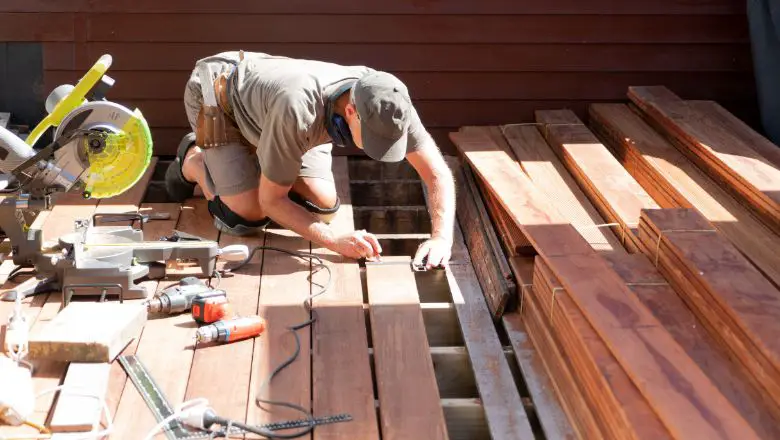When it comes to creating a beautiful outdoor space, decking is an excellent choice.
It’s versatile, affordable, and easy to install, making it the perfect DIY project.
Not only does it add value to your home, but it also extends your living space and creates an inviting atmosphere.
With these 5 budget-friendly DIY garden decking ideas, you can transform your outdoor space into a beautiful oasis without breaking the bank.
Benefits of DIY Garden Decking
There are many benefits to installing a DIY garden deck. First and foremost, it’s an affordable way to extend your living space outdoors.
It’s also a great way to add value to your home and create an inviting atmosphere for entertaining guests.
Additionally, a garden deck provides a smooth and level surface for outdoor furniture, BBQs, and other activities.
Finally, it’s easy to install and maintain, making it a popular choice for DIY enthusiasts.
DIY Garden Decking Guide

Planning and Preparation
Before you begin your DIY garden decking project, it’s important to plan and prepare. Start by measuring your outdoor space and sketching a rough layout of your deck.
Determine the size and shape of your decking, taking into account any existing structures, trees, or plants. Next, consider your budget and choose the right materials for your decking.
Finally, gather your tools and materials, including decking boards, screws, nails, saws, and drills.
Choosing The Right Materials
Choosing the right materials is crucial for a successful DIY garden decking project. There are several options to choose from, including pressure-treated lumber, cedar, redwood, and composite decking.
Pressure-treated lumber is the most affordable option and is resistant to rot and insects. Cedar and redwood are more expensive but offer natural resistance to decay and insects.
Finally, composite decking is a low-maintenance and durable option, although it’s more expensive upfront.
Decking Design Ideas
Once you’ve chosen your materials, it’s time to get creative with your decking design. There are many options to choose from, including simple rectangular or square shapes, multi-level decks, and curved designs.
You can also add features like built-in benches, planters, and lighting to enhance your deck’s functionality and style. Additionally, consider adding a pergola or trellis for shade and privacy.
Building The Decking
Building your garden deck requires patience, attention to detail, and a steady hand. Start by laying out your deck frame and securing it in place with concrete footings.
Next, attach your decking boards using screws or nails, taking care to ensure a level and even surface. Finally, add any finishing touches, such as railings, stairs, and latticework.
Maintenance and Care
To ensure the longevity of your garden deck, it’s important to perform regular maintenance and care. This includes cleaning your deck regularly, removing debris and stains, and sealing or staining your deck to protect it from the elements.
Additionally, check your deck for any signs of damage, such as rot or insect infestations, and repair them promptly.
5 Budget DIY Garden Decking Ideas for a Beautiful Outdoor Space
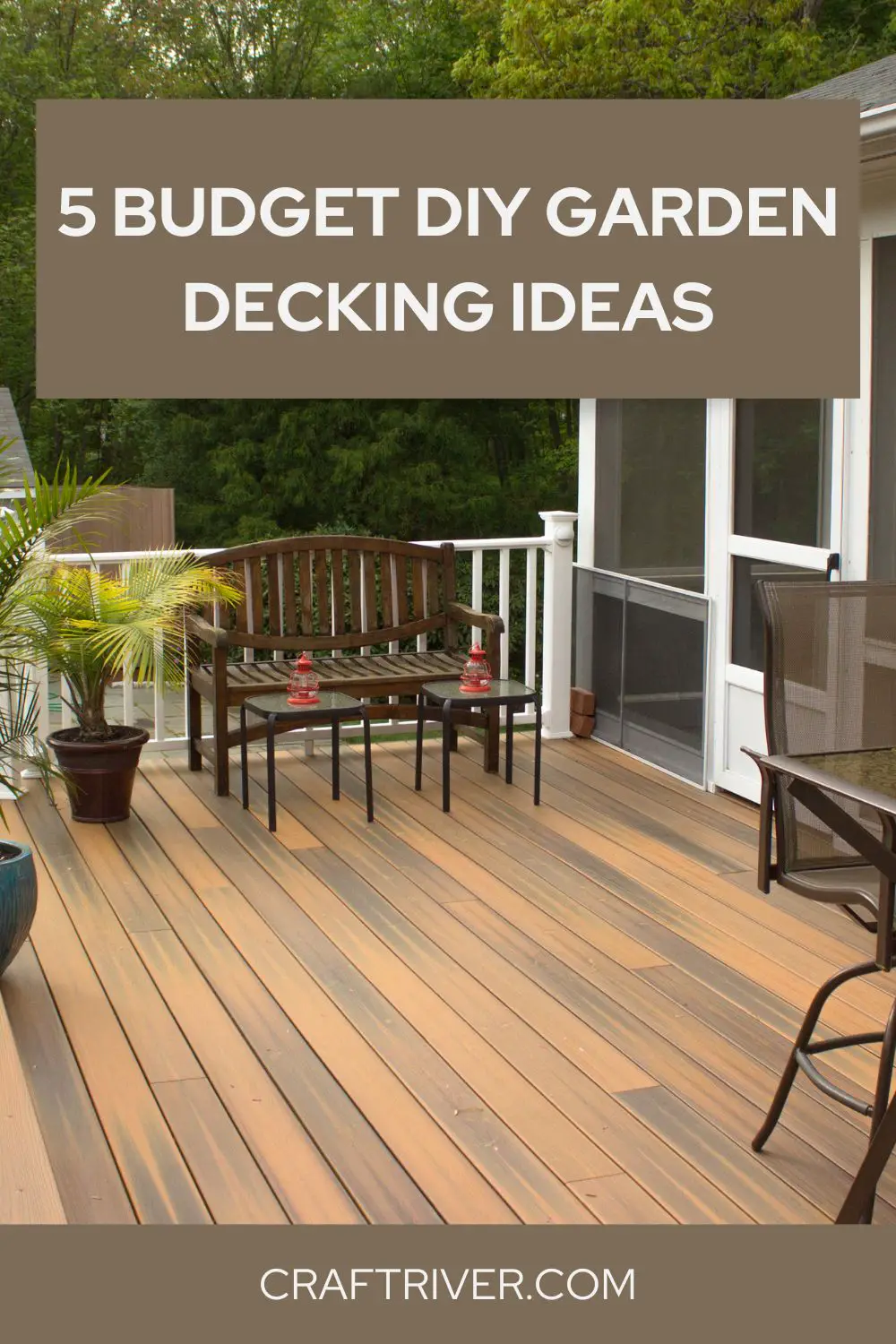
When it comes to creating a beautiful outdoor space, decking is an excellent choice.
It’s versatile, affordable, and easy to install, making it the perfect DIY project. Not only does it add value to your home, but it also extends your living space and creates an inviting atmosphere.
With these 5 budget-friendly DIY garden decking ideas, you can transform your outdoor space into a beautiful oasis without breaking the bank.
Idea 1: Pallet Decking

If you’re looking for a budget-friendly way to add some charm to your outdoor space, pallet decking may be just what you need.
This DIY project is relatively easy to do and can be completed on a weekend, even if you’re not particularly handy. Here’s what you need to know to get started.
Materials Needed
- Pallets (number depends on the size of your deck)
- Screws
- Sandpaper
Step-by-Step Instructions
- Measure and mark the area where you want to build your deck.
- Level the ground and make sure it’s firm and stable.
- Lay down the first layer of pallets in the desired pattern.
- Screw the pallets together at the corners and wherever they meet.
- Repeat steps 3 and 4 for additional layers until you reach the desired height.
- Use sandpaper to smooth any rough edges or splinters.
Pros and Cons of Using Pallets
Like any decking material, using pallets has its pros and cons. Here are a few to consider:
Pros:
- Low cost: Pallets are often free or can be purchased for a minimal cost.
- Eco-friendly: Reusing pallets instead of buying new wood reduces waste and helps the environment.
- Easy to install: Pallet decking can be a quick and easy DIY project, even for beginners.
Cons:
- Uneven surface: Pallets are not typically made to be decking material, so the surface may not be perfectly level.
- Potential for splinters: Pallets may have rough edges or splinters that need to be sanded down.
- Limited durability: Pallets are not meant to withstand the elements and may break down over time.
Cost-Saving Benefits
Pallet decking is an affordable option for those who want to add a deck to their outdoor space without breaking the bank. Instead of spending hundreds or thousands of dollars on expensive decking materials, pallets can be found for free or at a minimal cost.
Additionally, because this is a DIY project, you can save money on labor costs as well.
Final Thoughts
Pallet decking is a fun and easy DIY project that can be done on a budget. While it may not be as durable or long-lasting as other decking materials, it can still add charm and functionality to your outdoor space. If you’re looking for a low-cost option for your deck, give pallet decking a try.
Idea 2: Gravel Decking
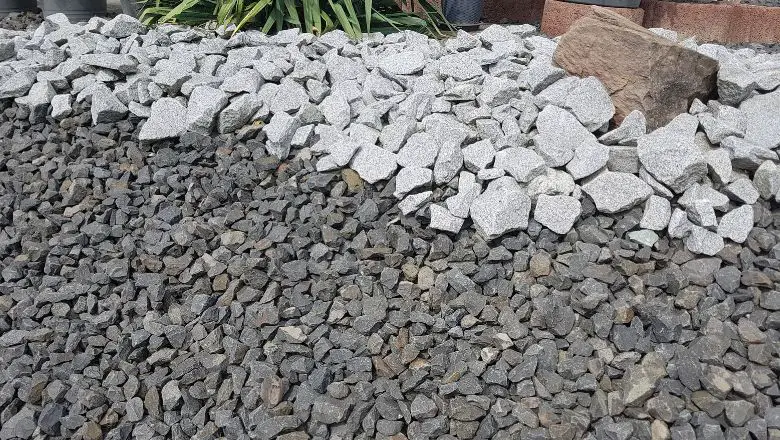
If you’re on a tight budget but still want to create a beautiful outdoor space, gravel decking is a great option to consider.
This DIY project is easy to do and can be completed in just a day or two, depending on the size of your deck. Here’s what you need to know to get started.
Materials Needed
- Gravel (quantity depends on the size of your deck)
- Landscape fabric
- Edging material (optional)
Step-by-Step Instructions
- Measure and mark the area where you want to build your deck.
- Remove any grass or vegetation from the area.
- Lay down landscape fabric to prevent weeds from growing.
- Spread a layer of gravel over the fabric, making sure it’s level and even.
- Use a tamper to compact the gravel.
- Repeat steps 4 and 5 for additional layers until you reach the desired height.
- Install edging material around the perimeter of your deck (optional).
Pros and Cons of Using Gravel
Like any decking material, using gravel has its pros and cons. Here are a few to consider:
Pros:
- Low cost: Gravel is an affordable option for decking material.
- Low maintenance: Gravel requires little to no maintenance once installed.
- Good drainage: Gravel allows water to drain through, reducing the risk of water damage to your deck.
Cons:
- Uneven surface: Gravel may not be perfectly level, which could make it difficult to walk on or set up the furniture.
- Potential for weeds: Even with landscape fabric, weeds may still find a way to grow through the gravel.
- May not be suitable for heavy use: Gravel decking may not be the best option for high-traffic areas, as it could get kicked around or displaced over time.
Cost-Saving Benefits
Gravel decking is an affordable option for those who want to create a deck without spending a lot of money. Gravel is relatively cheap, and if you’re willing to put in the work yourself, you can save on labor costs as well.
Additionally, because gravel requires little to no maintenance, you can save money in the long run on upkeep and repairs.
Final Thoughts
Gravel decking is a simple and low-cost option for those who want to create a beautiful outdoor space without breaking the bank. While it may not be suitable for heavy use or high-traffic areas, it can still add charm and functionality to your deck.
If you’re looking for a budget-friendly option for your deck, consider giving gravel decking a try.
Idea 3: Concrete Decking

Concrete decking may not be the first option that comes to mind when planning your outdoor space, but it can be a cost-effective and durable choice. Here’s what you need to know to create a concrete deck on a budget.
Materials Needed
- Concrete mix
- Water
- Wooden stakes
- String
- Rebar or mesh reinforcement
- Concrete sealer (optional)
Step-by-Step Instructions
- Measure and mark the area where you want to build your deck.
- Dig out the area to a depth of at least 4 inches.
- Place wooden stakes around the perimeter of your deck and tie string between them to create a level guide for your concrete.
- Lay down rebar or mesh reinforcement in the area.
- Mix your concrete according to the package instructions.
- Pour the concrete into the area and use a trowel to spread it evenly.
- Smooth the surface of the concrete with a float or trowel.
- Allow the concrete to dry for at least 48 hours.
- Apply a concrete sealer (optional).
Pros and Cons of Using Concrete
Like any decking material, using concrete has its pros and cons. Here are a few to consider:
Pros:
- Durable: Concrete is a long-lasting material that can withstand heavy use and harsh weather conditions.
- Low maintenance: Once installed, concrete requires little to no maintenance.
- Versatile: Concrete can be stained or stamped to create a variety of different looks.
Cons:
- High upfront cost: The cost of materials and labor for a concrete deck can be higher than other decking materials.
- Prone to cracking: If not properly installed, concrete can crack over time.
- May not be suitable for all climates: In cold climates, concrete can crack due to freeze-thaw cycles.
Cost-Saving Benefits
While the upfront cost of a concrete deck may be higher than other decking materials, it can save you money in the long run due to its durability and low maintenance requirements.
Additionally, because concrete can be poured into any shape or size, you can create a custom deck that fits your specific needs without having to purchase pre-made decking materials.
Final Thoughts
Concrete decking may not be the first option that comes to mind when planning your outdoor space, but it can be a cost-effective and durable choice.
While it may have a higher upfront cost, its longevity, and low maintenance requirements can save you money in the long run. If you’re looking for a durable and customizable option for your deck, consider giving concrete decking a try.
Idea 4: Wooden Pallet and Cinder Block Decking
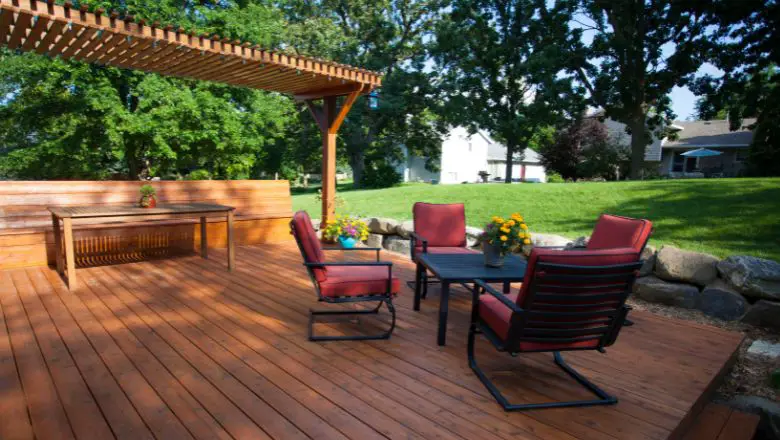
If you’re looking for a budget-friendly and versatile decking option, wooden pallets and cinder blocks might be the solution for you.
This DIY project can create a rustic and unique look for your outdoor space. Here’s how to build a wooden pallet and cinder block deck on a budget.
Materials Needed
- Wooden pallets (quantity depends on the size of your deck)
- Cinder blocks (quantity depends on the size of your deck)
- Gravel or crushed stone
- Landscape fabric
- Deck screws
Step-by-Step Instructions
- Measure and mark the area where you want to build your deck.
- Level the area and remove any grass or debris.
- Lay down landscape fabric to prevent weeds from growing up through your deck.
- Create a level base for your cinder blocks by adding a layer of gravel or crushed stone.
- Arrange your cinder blocks in a square or rectangular shape, leaving space in between for your pallets.
- Place your wooden pallets on top of the cinder blocks, ensuring that they are level.
- Use deck screws to secure the pallets to the cinder blocks.
- If desired, you can sand and stain the pallets to create a polished look.
- Add outdoor furniture and decor to complete your outdoor space.
Pros and Cons of Using Wooden Pallets and Cinder Blocks
Like any decking material, using wooden pallets and cinder blocks has its pros and cons. Here are a few to consider:
Pros:
- Budget-friendly: Wooden pallets and cinder blocks are often available for free or at a low cost.
- Customizable: The size and shape of your deck can be customized to fit your specific needs.
- Eco-friendly: Using recycled materials like wooden pallets can be an eco-friendly option.
Cons:
- Limited lifespan: Wooden pallets may not last as long as other decking materials and can be prone to rot and decay.
- May not be as sturdy: Wooden pallets and cinder blocks may not provide the same level of stability as other decking materials.
- May require additional maintenance: Depending on the condition of the wooden pallets, you may need to sand, stain, or seal them to prevent decay.
Cost-Saving Benefits
Using wooden pallets and cinder blocks can be a cost-effective option for decking.
With the right preparation and installation, this decking option can create a unique and customizable outdoor space without breaking the bank.
Final Thoughts
Wooden pallets and cinder block decking can be a fun and creative DIY project that allows you to customize your outdoor space on a budget.
While it may not have the same level of durability as other decking materials, it can be a great option for those looking for a budget-friendly and unique decking option.
If you’re feeling handy and want to give this DIY project a try, gather your materials and get started on building your own wooden pallet and cinder block deck.
Idea 5: Raised Garden Bed Decking
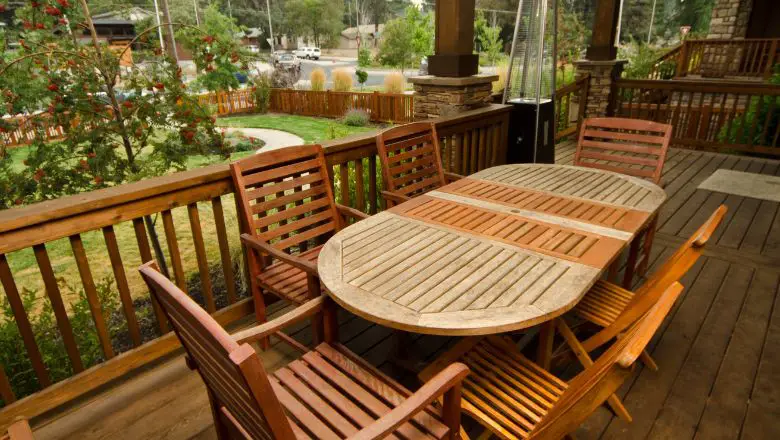
Of all the decking ideas on a budget, raised garden bed decking offers a unique twist.
Not only does it create an outdoor space for relaxation and entertaining, but it also doubles as a raised garden bed. Here’s how to create a raised garden bed decking on a budget.
Materials Needed:
- Garden soil
- Lumber (quantity depends on the size of your deck)
- Deck screws
- Landscape fabric
- Gravel or crushed stone
- Outdoor furniture and decor
Step-by-Step Instructions:
- Measure and mark the area where you want to build your raised garden bed decking.
- Create a level base by adding a layer of gravel or crushed stone.
- Use the lumber to create a rectangular or square frame for your garden bed.
- Secure the corners of the frame with deck screws.
- Add a layer of landscape fabric to prevent weeds from growing up through your garden bed.
- Fill the garden bed with garden soil.
- Add outdoor furniture and decor to complete your outdoor space.
Pros and Cons of Using Raised Garden Bed Decking
Like any decking material, using raised garden bed decking has its pros and cons. Here are a few to consider:
Pros:
- Dual function: Raised garden bed decking provides both an outdoor space for relaxation and a space to grow your plants and vegetables.
- Customizable: The size and shape of your raised garden bed decking can be customized to fit your specific needs.
- Good for small spaces: If you have limited outdoor space, raised garden bed decking can provide a solution for both relaxation and gardening.
Cons:
- Limited growing space: Depending on the size of your raised garden bed, you may have limited space for growing plants and vegetables.
- Requires maintenance: Like any garden, a raised garden bed requires regular maintenance such as watering, weeding, and fertilizing.
- Can be expensive: Depending on the size and materials used, raised garden bed decking can be more expensive than other budget-friendly decking options.
Cost-Saving Benefits
While raised garden bed decking may have its drawbacks, it can also provide some cost-saving benefits. By combining your outdoor space with a garden bed, you can save money on buying separate garden containers or beds.
Additionally, growing your plants and vegetables can save money on groceries in the long run.
Final Thoughts
Raised garden bed decking can be a unique and functional addition to your outdoor space.
By combining an outdoor space for relaxation with a garden bed, you can enjoy the benefits of both.
While it may not be the most budget-friendly option on this list, it can provide cost-saving benefits in the long run. If you’re looking for a way to create a functional and beautiful outdoor space, consider building your own raised garden bed decking.
DIY Garden Decks FAQs
Do I need a permit to build a DIY garden deck?
Depending on your local regulations, you may need a permit to build a garden deck. Check with your local building department for specific requirements.
Can I install garden decking on a slope?
Yes, it’s possible to install garden decking on a slope. However, it may require additional planning and preparation to ensure a level and stable surface.
What’s the best decking material for a tight budget?
Pressure-treated lumber is the most affordable decking material, making it a popular choice for budget-conscious homeowners.
How often should I clean my garden deck?
It’s recommended to clean your garden deck at least once a year to remove debris and stains.
How long will my garden deck last?
The lifespan of a garden deck depends on the materials used and the level of maintenance and care. With proper maintenance, a garden deck can last 10-15 years or more.
Conclusion
In conclusion, many budget-friendly decking ideas can help you create a beautiful outdoor space without breaking the bank. From pallet decking to raised garden bed decking, each option provides its unique twist and can be customized to fit your specific needs.
While each decking idea may have its pros and cons, the most important thing is to choose an option that works best for you and your budget. By getting creative and thinking outside the box, you can create an outdoor space that is both functional and beautiful.
Remember, the key to creating a successful budget-friendly decking project is to plan, use high-quality materials, and take your time. With a little bit of effort and creativity, you can transform your outdoor space into a relaxing and enjoyable oasis that you’ll love spending time in.
